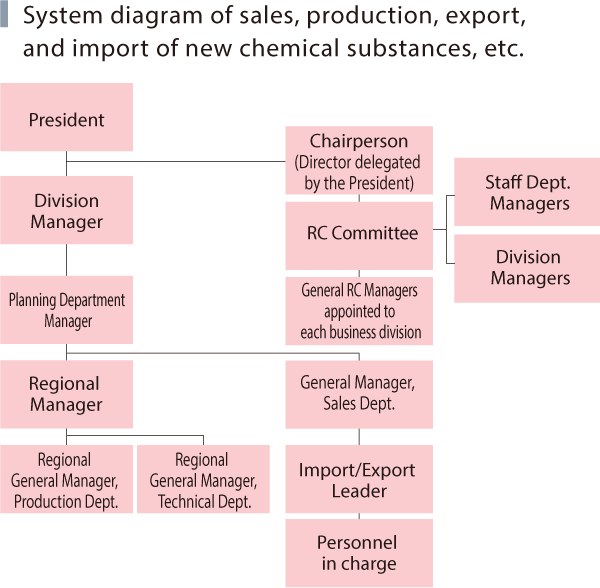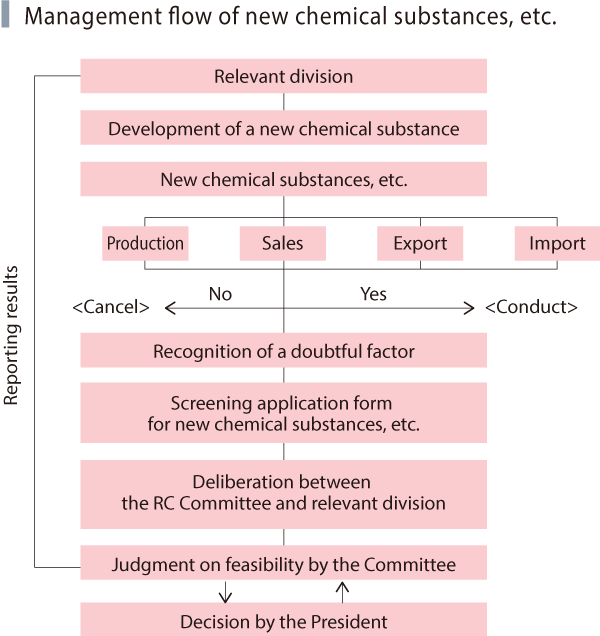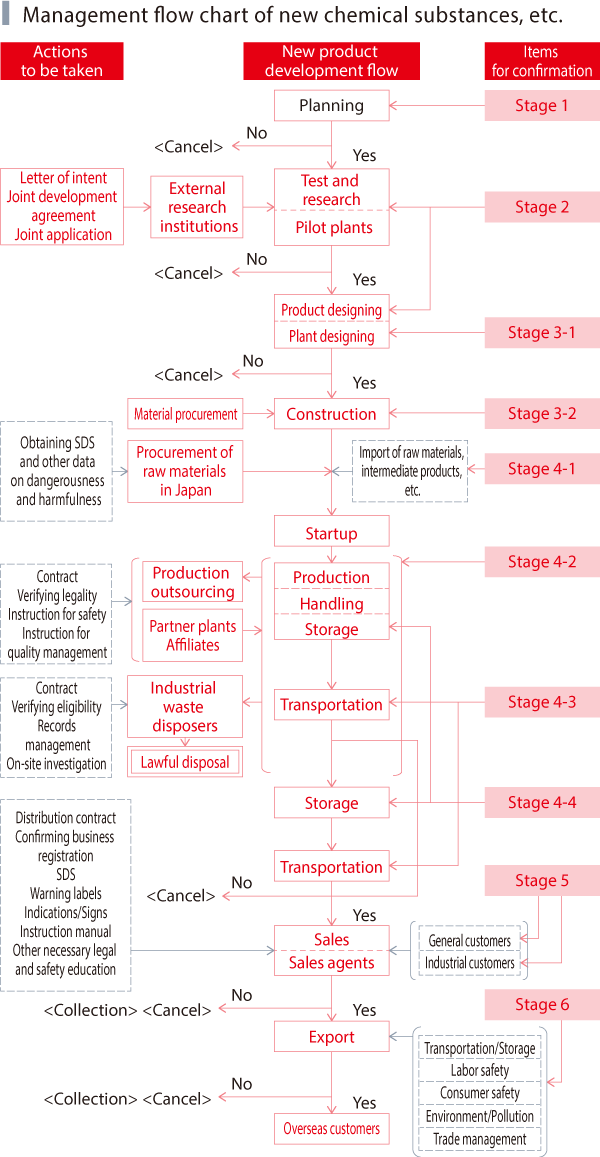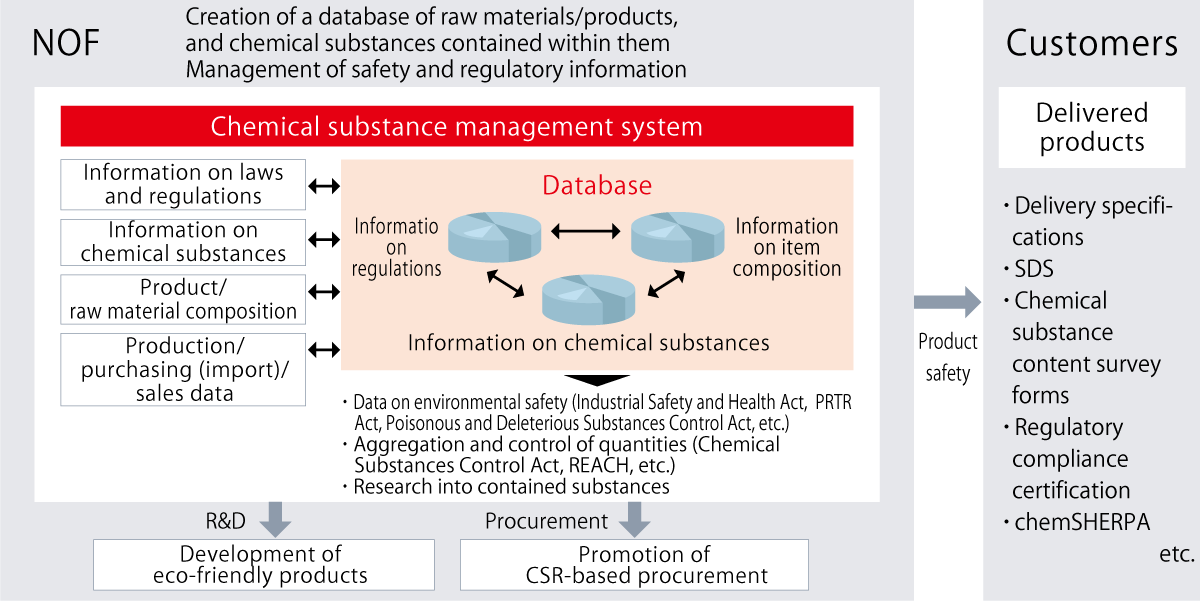Management and Handling of Chemical Substances
- TOP
- Sustainability
- Environment
- Management and Handling of Chemical Substances
System diagram of sales, production, export, and import of new chemical substances, etc.

Management flow of new chemical substances, etc.

Management flow chart of new chemical substances, etc.

Items for confirmation in management flow of new chemical substances, etc.
| Stage | Principal items for confirmation |
|---|---|
| 1 | (1) Quality planning (terms of use and impact on the environment, quality of competitors’ products, performance demanded by customers, selling points), (2) Trademark/Patent, Response plan to laws and regulations in Japan and overseas, (3) Development plan (system, schedule, R&D expenses, safety test expenses, etc.), (4) Production plan (production processes, facilities for research and trial experiments), (5) Sales and export plan, (6) Budget |
| 2 | (1) Confirmation of the details of marketability and salability (functions, safety, container/package, transportation method, measures against industrial wastes, expenses for production and selling, sales prices, energy saving issues, etc.), (2) Establishment of production processes and analysis/inspection method, (3) Research for the necessity of GLP and GMP (4) Research for specific value, reactivity, and explosiveness, (5) Confirmation of safety test expenses, etc., (6) Application of new chemical substances (Act on the Regulation of Manufacture and Evaluation of Chemical Substances and Industrial Safety and Health Act), (7) Research for CAS, TSCA, HCS, CEPA, WHMIS, EINECS, FD&C Act, etc., (8) Confirmation of SDS, warning labels, indications and signs, instruction manual, information on each type of toxicity, (9) Sales manual, (10) Contract details, (11) Application for patent and trademark, (12) Retention of documents and records |
| 3-1 | (1) Evaluation of cleaner production (reduction of wastes and prevention of generation), (2) SA on safety and disaster prevention for equipment, processes, and operations (including health problems), (3) Judgment on the effectiveness of the investment |
| 3-2 | (1) Industrial Safety and Health Act, (2) High Pressure Gas Safety Law, (3) Fire Service Act, (4) Explosives Control Act, (5) Act on the Prevention of Disaster in Petroleum Industrial Complexes and Other Petroleum Facilities, (6) Air Pollution Control Act, (7) Ozone Layer Protection Act, (8) Energy Saving Law, (9) Water Pollution Prevention Act, (10) Noise Regulation Law, Vibration Regulation Law, (11) Offensive Odor Control Law, (12) Waste Management and Public Cleansing Act, (13) Act on Prevention of Marine Pollution, (14) Building Standards Act, (15) Poisonous and Deleterious Substances Control Act, (16) Act on Securing Quality, Efficacy and Safety of Products Including Pharmaceuticals and Medical Devices, (17) Food Sanitation Act, (18) Act on the Regulation of Manufacture and Evaluation of Chemical Substances, (19) Agricultural Chemicals Regulation Act, (20) Act on Prevention of Radiation Hazards due to Radioisotopes, etc., (21) Act on Port Regulations, (22) Civil Aeronautics Act, (23) Road Transportation Act, (24) Factory Location Act, (25) Municipal ordinances on prevention of fire, pollution, etc. |
| 4-1 | (1) Prior confirmation of the presence of dangerous and harmful substance, (2) Examination of laws and regulations for the relevant substance, (3) Securing sufficient labor for SDS, warning labels, indications and signs, instruction manual, and others |
| 4-2 | (1) Building Standards Act, (2) Fire Service Act, (3) Act on the Regulation of Manufacture and Evaluation of Chemical Substances, (4) Explosives Control Act, (5) High Pressure Gas Safety Law, (6) Act on the Prevention of Disaster in Petroleum Industrial Complexes and Other Petroleum Facilities, (7) Act on the Rational Use of Energy, (8) Electricity Business Act, Gas Business Act, (9) JIS, (10) Law for the Promotion of Effective Utilization of Resources (11) Waste Management and Public Cleansing Act, (12) Act on the Regulation of Manufacture and Evaluation of Chemical Substances, (13) Industrial Safety and Health Act (Article 57-4 Ordinance on Prevention of Organic Solvent Poisoning, Ordinance on Prevention of Dangers Due to Specified Chemical Substances, Ordinance on Prevention of Tetraalkyl Lead Poisoning, Ordinance on Prevention of Lead Poisoning, Ordinance on Prevention of Dangers Due to Dust, Ordinance of Prevention of Ionizing Radiation Dangers), (14) Act on Securing Quality, Efficacy and Safety of Products Including Pharmaceuticals and Medical Devices, (15) Poisonous and Deleterious Substances Control Act, (16) Food Sanitation Act, (17) Agricultural Chemicals Regulation Act, (18) Act on Prevention of Radiation Hazards due to Radioisotopes, etc., (19) Implementation of SA, SOP, and measures for health problems, (20) PM system, QA (ISO 9000 series and JIS Z9900 series), and the completion of SDS, warning labels, indications and signs, instruction manual, etc. |
| 4-3 | (1) Explosives Control Act, (2) High Pressure Gas Safety Law, (3) Poisonous and Deleterious Substances Control Act, (4) Fire Service Act, (5) Act on Prevention of Radiation Hazards due to Radioisotopes, etc., (6) Railway Operation Act, (7) Road Transport Vehicle Act, (8) Road Act (underwater tunnel), (9) Ship Safety Act, (10) Act on Port Regulations, (11) Act on Prevention of Marine Pollution, (12) Maritime Traffic Safety Act, (13) Civil Aeronautics Act, (14) Postal Act, (15) Others (carrying documents, qualification, vehicle, container, loading standards, and indications and signs) |
| 4-4 | (1) Confirmation of precautions for indication/sign, (2) Confirmation of precautions for storage |
| 5 | (1) General and industrial customers: distribution of warning labels, indications and signs, and instruction manual, (2) Industrial customers: SDS, quality warranty card, contract, confirmation of business registration |
| 6 | ◎Transportation/Storage (1) UN, IMO (each code of IMDG · IBC · BC), ICAO, IATA(2) Europe: ADR, RID, EC Directives, (3) The US: 49CFR, CHEMTREC, NFPA, HCS, etc. ◎Labor safety (4) HCS, SDS, warning labels, indications and signs, instruction manual, etc. ◎Consumer safety (5) In addition to items presented in (4) above, product liability insurance and warranty card (limitation of warranty) ◎Environment/Pollution (6) The US: CAA, CWA, RCRA, CERCLA, SARA, TSCA, HCS (7) Canada: CEPA, WHMIS, (8) Europe: The Sixth and Seventh EEC Directives for Amendment, etc. ◎Trade management (9) Materials for chemical weapons, (10) Materials for narcotic drugs, (11) Harmful chemical substances, (12) Strategic materials (management and operation standards for strategic materials) |
Initiatives to improve information accuracy in chemical substance management
The NOF Group focuses on sustainable chemical substance management and is working to improve the accuracy of information on the following points.
NOF works to ensure reliable operation of the mechanism for providing safety data sheets (SDSs) through introduction of a chemical substance management system, enabling hazard information related to our products to be easily available to our customers and employees. Furthermore, by fiscal 2025, we plan to establish a company-wide chemical substance database and enhance the functions of our chemical substance management system. First, the chemical substance management processes will be digitized to ensure accuracy and rapid access to information. This ensures strict management of data related to the handling of chemical substances and supports efficient decision-making.
In addition, we are also working to expand the functions of the system to track and manage important information such as usage and handling history of chemical substances, in order to improve transparency and visibility. This allows us to more accurately assess the risks of chemical substances and their impact on the environment, and to help formulate sustainable management strategies.
Furthermore, strengthening partnerships is another important initiative. While building cooperative relationships with suppliers and customers, the NOF Group strives to improve its products through continuous dialogue with customers in order to provide appropriate products in terms of chemical substance management. We are also coordinating with industry groups and regulatory bodies to share information and know-how. In this way, we aim to contribute to raising the level of chemical substance management throughout the industry and to achieve further development.
Finally, our sustainability initiatives include the promotion of research and development. The NOF Group is focusing on the development of more eco-friendly chemical substances. We aim to provide high-performance products while minimizing negative environmental impact. In this way, we are working to achieve a sustainable business model while meeting the needs of our customers.
The above are the main points on which the NOF Group is working to improve the accuracy of information on chemical substance management. The NOF Group aims to maintain the trust of its customers and provide valuable returns to all stakeholders while pursuing sustainable management.

(Click to enlarge)
Chemical substances risk assessment
The NOF Group strives to reduce all risks of occupational accidents and to prevent their occurrence. Among them, in order to ensure compliance with the Ordinance on Industrial Safety and Health, which was revised and came into effect on April 1, 2023 to prevent occupational accidents caused by chemical substances, we have set this risk assessment as one of the implementation items related to occupational safety in the RC activity targets for fiscal 2024, and are checking the implementation status during regularly conducted RC audits. Chemical substance risk assessment is one of these, and we have established a system to ensure that we do not omit anything in responding to the increasing number of substances subject to assessment each year.
Wearing protective equipment
Following this revision, not only is it mandatory to appoint a chemical substance control whose duty is to autonomously manage chemical substances, but it is also mandatory for employees who handle chemical substances to wear protective equipment and for a person in charge of protective equipment to select appropriate protective equipment and manage its use. The NOF Group is once again working to ensure the wearing of protective equipment, which it required from before and has established a management system in line with the revised law.

